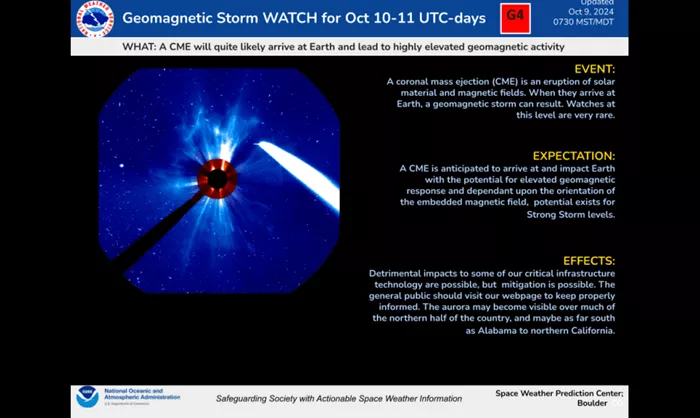NOAA Issues Geomagnetic Storm Warnings as Severe Solar Activity Looms
The National Oceanic and Atmospheric Administration (NOAA) has issued a G3-level “strong” geomagnetic storm warning, escalating its earlier G4-level “severe” storm watch following the arrival of a coronal mass ejection (CME) at Earth at 11:15 a.m. EST on Thursday. The CME, traveling at nearly 1.5 million miles per hour, poses a significant risk to power grids already strained by recent hurricanes.
NOAA first announced the G4 watch on October 9, proactively alerting the North American power grid in anticipation of the CME’s impact, expected between Thursday morning and midday. The agency warned that disruptions to communications, navigation systems, and power infrastructure could complicate recovery efforts in areas still reeling from Hurricanes Helene and Milton.
The severity of geomagnetic storms is measured by NOAA using the K-index scale, with G5 representing the most intense storms and G1 the least. The latest solar storm, triggered by a fast-moving CME that erupted from the sun on October 8, had its speed initially estimated between 1,200 and 1,300 km/s by the following afternoon.
As the CME reached Earth, NOAA continued to monitor its strength and structure to evaluate the potential intensity of the geomagnetic storm. By 11:57 a.m. EST, NOAA confirmed that G4 levels had been observed, warning of potential voltage control issues and increased satellite operation anomalies. In an update at 6:37 p.m. EST, G4 storming levels remained stable, with a chance of escalating to G5 levels overnight.
In response to the situation, the North American Electric Reliability Corporation (NERC) issued a warning, prompting PJM Interconnection to activate its protocols. While PJM does not anticipate major disruptions, it acknowledged that severe geomagnetic disturbances (GMD) are rare and emphasized the need for caution.
“This is a very speedy CME—it’s the fastest we’ve measured with a total Earth-directed component,” said Shawn Dahl, service coordinator at NOAA’s Space Weather Prediction Center (SWPC). He explained that the solar wind is monitored by spacecraft positioned one million miles from Earth, which helps predict the potential impacts of CMEs on geomagnetic storms.
The ongoing solar activity corresponds with an uptick in geomagnetic storms linked to Solar Cycle 25, which has already produced over 50 X-class flares since late 2019. Experts warn that this current storm could lead to significant disruptions, particularly as the region grapples with the aftermath of Hurricanes Helene and Milton.
Hurricane Helene recently devastated Florida’s Gulf Coast, leaving nearly 6 million customers without power at its peak. Although power restoration has progressed, many areas still face challenges due to damage to electrical systems. Meanwhile, Hurricane Milton made landfall as a Category 3 storm, raising concerns about potential impacts on the state’s natural gas infrastructure.
NOAA has cautioned that the incoming solar storm could further complicate recovery efforts. Communications systems dependent on low-Earth orbit satellites may experience disruptions, and power grids already weakened by the hurricanes could face additional strain.
“We’ve been in contact with power grid operators to ensure they are prepared for the storm,” Dahl added. As the geomagnetic activity escalates, the potential for auroras may extend further south than usual, possibly reaching areas as far as Northern California.
Although Florida may be less affected due to its latitude, NOAA emphasizes that the status of electrical systems in the state remains uncertain, particularly as recovery efforts continue. The agency is closely monitoring the situation and will provide updates as conditions evolve.
This developing story underscores the complex interplay between severe weather events and solar activity, highlighting the challenges faced by power grid operators and emergency responders in the wake of natural disasters.
Related topics:
- Next-Gen Service Vessel for Floating Wind Farms Unveiled in New Partnership
- Wind and Solar Set to Surpass Hydropower, Says IEA
- EDGE Innovate Unveils Revolutionary Shredder to Combat Wind Turbine Blade Waste

